It’s really discouraging to see your aquarium efforts go to waste because of a single parasitic outbreak.

A reef-safe treatment for fish with marine Ich exists but it requires a bit of dedication and a couple of inexpensive gadgets.
In fact, I’ve tried what I’m about to describe on two separate aquarium systems and it worked flawlessly both times.
You’ll be able to save your ill fish without harming your corals and invertebrates or having to set up a new tank.
In this guide, I will teach you how to safely treat the Ich parasite in your display reef tank and show you the science that backs my methods up. But if these methods are so efficient, why aren’t more people talking about them?
What is the reef-safe Ich treatment?
When my aquarium was first faced with the parasitic outbreak I sat down and thought in depth about a solution.
I came to the conclusion that the only approach that stands a chance of working while being safe for my reef tank was an Ich treatment that targets the fish and not the aquarium water.
After doing some research I stumbled upon some very promising information which I then tested and had success with.
Here’s the kind of treatment that will safely work against marine Ich in a reef tank:
Water oxidation and feeding fish a diet rich in quality foods are reef-safe methods that build a natural immunity toward the Ich parasite. If these treatment methods are applied on time and for a continuous period, the fish would be able to successfully overcome the Ich infection on their own.
Note that there’s no known medication that can eradicate marine Ich from reef fish while being harmless to corals and other invertebrates inside a display tank. Even products that are marketed as reef safe like Kick-Ich, have been reported to harm invertebrates.
Furthermore, such products have a questionable success rate even when they’re used in reefless systems.
Out of all the accounts I’ve found about Kick-Ich most seem to find it extremely ineffective.
And in the ones where there were any results, they boiled down to a small decrease in the number of free-floating theronts.
Clearly, you will get rid of the entire issue by building up the immune system of your aquarium fish rather than trying to eradicate the parasites from your display tank. The former requires little work and is easy on the fish whereas the latter is often impractical and stressful for them.
Also, if you’re not sure whether it is actually Ich you’re fighting, consulting with a vet might be a smart idea.
Who is this treatment method for?
The usual go-to method of treating saltwater Ich is setting up a hospital aquarium and relocating the ill fish there. In the meantime, you’ll want to wait for the parasites in the display tank to die out which takes about 2.5 months.
Without a host in the main reef aquarium, Ich will complete its life cycle and be done with.
Nevertheless, capturing 10 or more saltwater fish in a 200-gallon reef tank with custom rock work is nearly impossible at times.
Not to mention the great deal of stress this can cause to a fish that already has its immune system compromised.
You could just helplessly wait for all of your marine fish to perish and then leave the aquarium “fishless” for 76 days, true. That’s hardly anyone’s desired course of action though.
The treatment I’m about to describe is ideal for people who don’t want to spend hours chasing fish around their reef tank with a questionable success rate.
Another decent argument for going down this road would be that most of us won’t necessarily have the means to set up a separate hospital fish tank and maintain that for the upcoming months.
It requires space, resources, time, and experience.
Before I tell you what worked for me I need to make a few clarifications.
What can you expect during and after the treatment?
My reef tank treatment method will not kill Ich.
The parasite will likely remain in the system, but it will be kept under control.
The method allows for your ill saltwater fish to safely handle the symptoms and build up their immune system enough to fight Ich on their own.
There’s plenty of research showing that fish can build up a natural immunity to marine Ich. At this point, some aquarists may argue that letting the parasite survive inside the aquarium will be somewhat inhumane.
However, that’s hardly the case as this happens literally all the time in the ocean.
In the wild, saltwater Ich, also known as Cryptocaryon irritans, is constantly present in seawater.
So how do marine fish handle it all the time?
Simple – dilution of the parasitic numbers, which allows the healthy fish to successfully fight it off with the help of a good immune system.
I’m about to tell you how to replicate just that and avoid having to tear down your reef aquarium.
You’ll keep the number of parasites in the aquarium water in check while giving your saltwater fish the upper hand.
My experience has been that this way the fish will live a normal and happy life for years to come.
Ich control works and has been working for many of us with successful reef aquarium systems.
It’s important to remember that the treatment method I’m about to describe is meant to be carried out inside of a display tank that also houses corals and invertebrates.
That’s somewhat of a luxury given how fragile these creatures are.
Nevertheless, this method should be regarded as a last resort, when no other option for treatment seems feasible.
If an opportunity to set up a hospital aquarium opens, you should probably do that.
Treating fish infected with marine Ich in a separate tank gives you a realistic chance to get rid of the parasite once and for all.
If you have the time and resources to do that you can look up “saltwater Ich” in the search bar of this website and give my in-depth article on the subject a good read.
The search bar is located in the upper right corner on desktop devices and at the bottom of the page on mobile ones.
Let’s cut to the chase.
How to treat saltwater Ich inside of a display reef tank?
In this step-by-step guide, I will tell you how I managed to successfully banish Ich from a display aquarium with corals in 2 out of 2 tries.
I first tried this method out of desperation in my own reef tank and the second time was when I was advising my good friend who owns a massive 200-gallon system with plenty of SPS and LPS corals. Both times I was able to completely stop the ongoing fish mortalities and the outbreaks never returned.
In the following years, we were able to introduce new fish to our reef aquariums without any issues. On rare occasions, a newcomer fish would develop a few white spots, but then the spots would completely disappear and the fish would move on with its life.
With that being said, I can share how I achieved all of this without harming our reef corals, along with my reasoning behind each step.
Follow these exact steps to properly treat marine Ich in a display reef tank:
1. Set up an aquarium Oxydator with a 12% Hydrogen Peroxide solution.

Hydrogen peroxide (H2O2) is a well-known oxidant that kills microorganisms through oxidation.
Oxidation is the release of highly reactive oxygen radicals, which strip electrons from the walls of cells, destroying microorganisms in the process.
After desperately searching for a treatment method that would also be safe for my reef corals I stumbled upon a couple of promising reports.
They would describe successfully managing an Ich outbreak in a display tank with Hydrogen Peroxide.
It’s important to note that none of these people reported a negative effect on their established aquarium biofilters. Being able to preserve my biofilter was more than welcome and actually in line with what the USGS found from reviewing multiple studies on the subject.
Anyway, I was already aware that Hydrogen Peroxide is safe for corals and other marine invertebrates because people were using it to fight cyanobacteria in their reef aquariums for years.
I then used my research skills and dug down further. Evidently, there’s a study that describes Hydrogen Peroxide killing marine Ich theronts (free-floating stage of the parasite’s life cycle).
During my research I found another study showing scientific proof of H2O2 eradicating the Amyloodinium parasite, also known as Marine velvet.
Both marine velvet and Ich are external protozoan parasites with very similar life cycles so I decided that it makes sense to give Hydrogen Peroxide a try.
Before I continue I need to make sure you’re familiar with the life cycle of marine Ich:

During an outbreak, the Ich tomonts release infective theronts sporadically.
This means that the release is not coordinated between Tomonts and could happen at irregular intervals.
On the other hand, Hydrogen Peroxide degrades in just a couple of hours in aquarium water, because of the many organics found in a reef aquarium.
I also knew that the tomonts would only hatch between 2 AM and 9 AM. All of this made me give up my initial intention to dose the Hydrogen Peroxide manually.
I could only do so a limited amount of times and each dose would last 1 to 3 hours in the water.
I needed a device of some sort that would allow me to continuously supply the chemical in the reef aquarium.
This way the oxidation process would kill the Theronts whenever they are released from the Tomont cysts.
After some more research, I came across what’s known as an Oxydator.
An oxydator is exactly that – a device that would slowly release Oxygen molecules and Hydrogen peroxide in the aquarium over time.
The way an oxydator works is by using ceramic catalysts that react with hydrogen peroxide and slowly release active oxygen in the water.
The amount of oxygen that gets released in the water depends on the water temperature and number of catalysts that are used.
At higher temperatures, the oxydator yields more active oxygen but suffers a decreased operating time.
Worry not, however, since this simply means the hydrogen peroxide solution depletes quicker at increased temperatures.
Once it gets refilled, the oxydator resumes its normal functioning.
On top of being perfect for my situation the device itself was very inexpensive, and, evidently, works without the need for electricity or batteries.
I quickly found the most reliable brand based on what people were saying online and ordered. I went with this Oxydator both times I tried this treatment method.
Oxydators are not easily found in the US but Amazon usually has a steady supply.
Mind that, for this to work properly, you need to get one that’s suitable for your total volume of aquarium water.
We ordered the two A versions for my friend’s 200-gallon reef tank, as each A is rated for up to 105 gallons of water.
For my 100-gallon aquarium, I ordered a single Oxydator A.
If the larger version is out of stock you can just order 2 smaller ones to make up for the total volume of released Hydrogen Peroxide, as we did.
Anyway, I was already seeing fish showing the telltale signs of, and dying so I wanted to start the treatment immediately. Until the Oxydator was delivered, I manually dosed 1 ml of 3% Hydrogen peroxide per 5 gallons of total water volume (sump included), 2 times a day.
I took this dosage based on other reports and it seemed well within the safe range for fish and corals.
I dosed that directly in the display tank and none of my aquatic creatures showed signs of additional stress.
I did the same for my friend’s fish tank where one anemone seemed displeased at first but went back to normal in 2 days.
When you manually dose, make sure to turn off the powerheads for about an hour.
I also made sure to dose right after lights out, and one hour before they turn on because light speeds up the degradation of Hydrogen Peroxide.
This way I was efficiently targeting the release of Theronts during the night and the Hydrogen Peroxide stayed as much as possible in the water.
Make sure to only use a food-grade 3% H2O2 solution with no additives.
You can get that at your local pharmacy.
Anyhow, you will likely witness a positive effect almost immediately after dosing.
What I saw in the next couple of days was the trophonts falling off my fish and the gradual decrease of white spot density on their bodies.
The rate at which it was happening was not in line with the ever-multiplying white dots I was observing before the treatment.
The study I linked to above confirms this effect of Hydrogen Peroxide and the scientists did not attribute it to the natural life cycle of C. irritans.
Anyway, when the Oxydators arrived we set them up and used 2 catalysts per device.
Catalysts are small ceramic pieces that come with the Oxydator and control the release of Hydrogen Peroxide into the water.
The more catalysts you use, the faster the release of Oxygen and Peroxide.
Since with the Oxydators we have more control over the released amount, we both used a 12% Hydrogen Peroxide solution during the treatment.
No corals or fish were harmed or showed any negative reaction to that.
Food-grade solutions with no additives of this strength are commercially available. Something like this combined with an Oxydator can work safely in a reef tank.
Our saltwater fish began to improve even faster and mortalities ceased completely.
Both times I tried this there were fish that I thought would not make it.
Both times these fish improved and returned to normal behavior.
What not many know is that the most common reason for fish deaths during a severe Ich outbreak is suffocation. The parasites clog the fish’s gills and block their oxygen intake.
Hydrogen Peroxide both oxygenates the water enough for fish to breathe and forces the trophonts to leave their host.
This alone is enough for a fish to get back on track and strengthen its immune system against further infestations.
An additional benefit my friend and I witnessed with the introduction of Hydrogen Peroxide to our reef tanks was the immense improvement of water clarity.
We observed the water becoming crystal clear to the point where our fish looked as if they were floating in the air.
Mind that said water clarity may increase the PAR potential of your aquarium lights because light penetrates clear water easier.
Tune them down a bit if you notice symptoms of over-illumination in your corals.
Another bonus of using this reef-safe chemical was the complete disappearance of all cyanobacteria.
It’s worth noting that we were both running refugiums with Chaetomorpha algae, which remained unaffected.
Anyway, I recommend putting the Oxydator directly in the display tank during the outbreak.
It will not be the prettiest piece of decor, but you can safely relocate it in the sump after the Ich infestation subsides, in case you don’t like its look.
At this stage, leave it in the display aquarium and refill it when needed (usually in about a week or so).
And one interesting update about Oxydators:
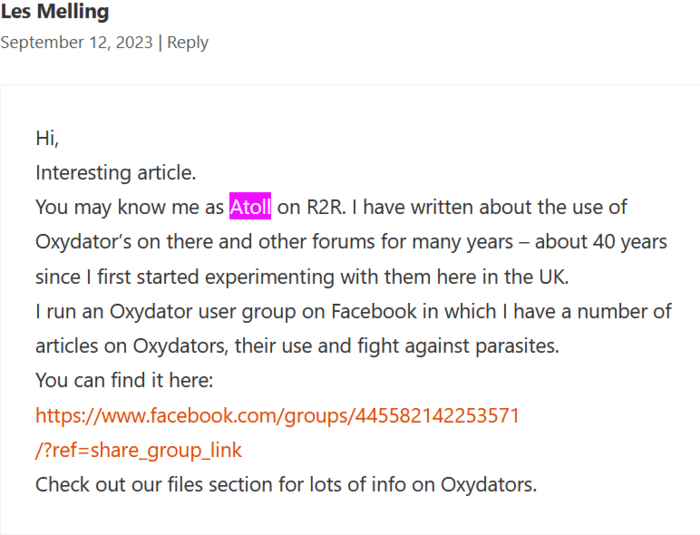
As you can see in the picture, Atoll, one of the members of the Reef2Reef forum who have been advocating for running Oxydators against marine Ich, has acknowledged my article and left me a comment.
I know this sounds kind of nerdy, but his comment got me super excited. His wealth of knowledge and experience on the topic played a huge role in me deciding to research this method and try it.
He left a link to a non-sponsored Facebook group dedicated to running Oxydators in aquariums which can be a great way to get even more answers from experienced people in our community. If you happen to join the group, make sure to put in a few good words about my article!
2. Feed your fish 100% live food with added Omega 3.

By feeding your marine fish only live foods you allow them to strengthen their immune response and fend off the Ich parasite.
My reasoning for trying this was that wild fish live among, not just Ich, but all kinds of pathogens, yet most of the time they’re able to handle them successfully.
Another argument that pushed me to dig deeper into this approach was the fact that I’ve previously seen reef tanks with fish who have survived Ich without being treated with medicine.
This led me to believe that fish could build up a sort of immunity to the parasite.
I found a couple of studies confirming this (I linked to one of those earlier) so I went ahead and kept looking for ways on how to do it.
With having an Oxydator to keep the number of free-floating Ich Theronts in check I only needed a way to help my fish with building up their immune response further.
I had also read enough scientific literature on the subject and already knew that the quality of a fish’s diet is directly linked to its health. Feeling confident in my knowledge, I decided to stop feeding pellets to my fish entirely and only offer them live, or recently frozen live food.
This way I would replicate the diet of a wild fish, which would introduce beneficial gut bacteria that aquarium fish can’t get from dried, processed pellets.
My reasoning was that I needed to revive the existing gut microbiome of my marine fish by feeding them critters that have their own natural microbiome in them.
I observed behavioral improvement just 2 to 3 days after switching the pellets with the 100% live food regimen.
We repeated the same in my friend’s reef tank.
The fish would stop scratching and would become lively again.
In fact, I ended up maintaining that regimen to this day, and all the fish who went through that outbreak are still alive and healthy.
I only had fish die before starting the combined treatments.
One important thing to remember here is that when your fish are sick with Ich you should feed them at least twice a day.
They need the energy and nutrients in order to fight the parasite off.
I mixed up some garlic with the live food during the outbreak. This way I made sure the ill fish had their share of live food because garlic is a well-known appetite stimulant.
There’s some controversy on garlic and marine fish as some claim that its continuous use damages their liver in the long run.
I could not find any scientific data to support that claim, but, as a precaution, I only use it when needed.
Additionally, garlic itself is a well-known immunostimulant that boosts the immune response in fish.
The wondrous properties of garlic stem from an organosulfur compound known as allicin. Several studies have shown that allicin content in garlic can strengthen immunity by increasing cytokine gene expression.
If you don’t like the smell of garlic, you can substitute it with Seachem’s Garlic Guard. Anyway, you could also add Selcon (see it on Amazon) to the meals, as it is a combination of vitamins, and Omega 3.
Speaking of which, during my research I actually found this study which explains how Omega 3 could actually boost a fish’s immunity and resistance to external parasites.
In fact, the scientists tested their subjects precisely with the saltwater Ich parasite.
This was more than enough proof for me to buy a bottle of generic fish oil with Omega 3 and add some to the live food I was using in my reef tank.
I think the combination of live food and fish oil can, on its own, repel a severe Ich outbreak. If you’re wondering what Omega 3 source I used, something like this would do.
With time and experience, I came up with a strict rule to only feed my fish food with added Omega 3 in it, because of how beneficial it is to them.
Anyhow, you can use all types of live food for this to work.
Some of the foods my friend and I used were live blackworms, live or frozen Mysis shrimp and, if we could get our hands on it, fresh mussels. White worms are also a good option as they don’t require much care and multiply fairly fast if you’d wish to cultivate them.
In my experience, the best approach here is to order live aquarium food through some of the reputable aquarium vendors online (AquaBid is a good place to start). Most fish stores won’t have enough to supply you with the needed quantities, but you can ask around if you have free time.
Another way to do this is by preparing your own mix of fresh fish food at home:
- Find some fresh, whole fish (guts and bones included) and mix it with some shrimp or squid.
- If you can buy clams or have a friend who can supply you with worms – throw that in, as well.
- Diversify the meal by adding a type of marine algae of your choice.
- Add Omega 3 capsules.
- Blend the whole thing and don’t forget to include the fish heads and guts.
When wild fish prey they never spit anything out and they are programmed to benefit from all the ingredients of the kill. For this reason, it’s better if you use whole fish in the mix.
Also, don’t forget to add a couple of Omega 3 softgels to the mix before throwing it in the blender.
Anyway, before blending, add water (dechlorinated and purified through Reverse Osmosis and/or Deionization) or your blender will have a hard time.
After that, you can blend the whole thing well, freeze it in a bag and store it in your fridge.
You just cut pieces of the frozen mixture and soak them in aquarium water before feeding.
In any case, something worth mentioning here is to have a good, strong blender in place.
Another thing to consider is the smell of the mixture. You may want to have a separate blender for this, but that’s up to you.
Though it looks unappealing, a good rinse with dish soap will remove the smell from the blender.
How to maintain these results in the long run?
After about 2 weeks of this Ich treatment, your saltwater fish will likely be as healthy as ever.
Your reef tank will also look perfectly clear, because of the oxidation processes inside.
Your corals will remain perfectly safe during the treatment and there will be no losses.
The oxidation processes will also take care of the increased organics in the water that came with the multiple-per-day feeding.
Hydrogen Peroxide will prevent the build-up of ammonia by directly oxidizing a large part of it to nitrate, aiding the biofilter. So, to keep this beautiful picture going you need to make sure your fish are not stressed.
Here’s how to maintain your reef tank free from Ich outbreaks after the treatment:
- Throw in an extra heater. A fluctuating water temperature is one of the most common reasons for stress and a weakened immune system in aquarium fish.
I really need to emphasize how prevalent and yet overlooked this is.
What my friend and I did was add an extra aquarium heater or two to our reef tanks. This way we made sure the water temperature remains steady, even during the night, which is when most of the fluctuations happen.
- Don’t use a UV sterilizer in conjunction with the Oxydator. If you’re going to use oxidation for Ich control only choose one of these methods and don’t run them simultaneously.
I won’t get too technical about it, but I did some research and it turns out the combination may prove a little too strong.
Irradiating Hydrogen Peroxide with strong ultraviolet light causes a reaction known as an Advanced Oxidation Process (AOP). An AOP produces hydroxyl radicals that are multiple times more reactive than any other oxidant that can be used in water.
I initially thought of combining a UV sterilizer and an Oxydator to combat saltwater Ich, but after greatly improving my knowledge in chemistry I deemed it unsafe.
I have no idea if the radicals will remain in the tube of the UV sterilizer or simply spread in all of my tank’s water and potentially over-sterilize the water, killing everything in the process.
Side note: If anyone with a degree in chemistry is reading this, let me know in the comments so I can upgrade this section.
Anyway, a strong UV sterilizer with a high “dwell time” will also be able to keep the Ich population in check.
If you want to use that instead of an Oxydator you can click here to visit my guide on choosing the right unit size for your reef tank. However, since you want it for pathogen control you should likely get the ones I recommend for tanks that are 50 gallons larger than yours.
For example, if you want to control Ich in a 75-gallon fish tank, check my UV filter recommendation for 125-gallon tanks or the ones I explicitly mention as being effective against pathogens.
- Dilute the Hydrogen Peroxide solution to 6 or 9%. After the outbreak has been handled you do not need to keep the Hydrogen Peroxide solution in the Oxydator at 12% strength.
Though there would be no problem with that, from my experience a 6 or 9% solution is effective for ongoing maintenance of the reef tank.
After treating the outbreak, I personally started diluting the 12% Hydrogen Peroxide solution with some RO water to about 9% strength. I have been continuously using that in my reef tank with no ill effect on my fish or corals in the long run.
You can also relocate the Oxydator to your sump if you don’t like how it sits in the display tank.
- Keep feeding live food and Omega 3 to your fish no matter what. Stick with the live food regimen and stay away from pellets as this will keep your saltwater fish in top shape.
Your fish pairs are very likely to start spawning under these conditions.
This is a really good sign that a fish feels safe and healthy.
Both my friend and I keep fish that spawn to this day, which is something I’d never expect to happen from simply switching their pellets with live food.
- Make sure there’s enough flow in the aquarium. Sufficient flow keeps saltwater fish active as if they were in the wild.
A good water current stimulates the fish’s muscles and keeps them toned.
This in turn may fasten their metabolism and immune system response. I know a few experienced reefers who swear by having strong powerheads</> in their hospital fish tanks and claim that it helps fish go through disease easier.
Persistent myths about Ich control in a reef tank
I feel obligated to address the common misconceptions that relentlessly get repeated over and over again.
Most of what I’m about to discuss in this section has been inspired by my time spent in online reefing communities. The popularity of these communities makes them very influential. However, I’m a firm believer that authority obliges you to be responsible for the information you provide.
Here are a couple of myths that you need to be aware of when it comes to Ich management:
1) Myth: “Anything that doesn’t kill corals and invertebrates won’t kill Ich.”
This is one of the more popular autopilot phrases when it comes to Ich treatments.
However, that statement is, evidently, false.
There’s literally scientific, peer-reviewed proof that oxidation kills Ich Theronts.
It’s not up for debate, the studies are out there and I linked to one of them earlier.
I’m far from the first person to have success with Hydrogen Peroxide in a display aquarium with corals and invertebrates.
Will this treatment kill all of the Ich parasites in your reef tank?
Unlikely.
Will it kill most of them and let your fish build their resistance toward marine Ich?
Without a doubt, given you do it properly.
2) Myth: “There is no such thing as an invertebrate-safe Ich treatment.”
…And this is usually followed by:
“There are only 4 known methods to treat Ich and they all require a separate hospital fish tank…”.
Needless to say, people tend to mistake the word “treatment” with the word “eradication”.
In most cases, when we get sick, we actually treat the symptoms and let our bodies deal with the disease.
At this point, you should know that a healthy, non-stressed fish will be able to fight 95% of diseases with its natural, built-in immune system.
Marine Ich is very unlikely to kill a fish that’s kept in excellent breeding conditions.
Small populations of Ich in the aquarium water are more or less the same as vaccination for the fish.
Following these thoughts, when someone asks if there’s an Ich treatment that can be carried out in a display reef tank, it’s very likely that they mean “will I be able to save my fish without harming my corals”.
The answer to that question should always be “Yes, you can either keep the parasite’s population under control or eradicate it with the help of a separate hospital fish tank.”
3) Myth: “If the white spots went away during treatment then it’s due to the life cycle of Ich.”
In one of the studies, I cited above the scientists explicitly mention that Hydrogen Peroxide was observed to force trophonts to leave their host.
Besides, let me elaborate further on why this way of thinking is often wrong.
Other studies on C. Irritans show that each Tomont cyst will release hundreds if not, thousands of free-swimming infective Theronts.
Though only between 5 and 20% of the Theronts will succeed in infecting a fish under ideal conditions, that’s still a lot.
As established earlier, Tomonts won’t all release their Theronts at the same time, in the same instant.
By doing some math you’ll see that with this pace of reproduction you should observe a growing number of white lesions on your fish during an active Ich outbreak.
This is always the case if no actions to improve the condition of a weakened fish are taken.
However, If you start the treatment and see the white spots decreasing or disappearing and not coming back in a few days then what you’re doing likely has a real impact on the ever-multiplying population of the parasite.
4) Myth: “During Ich management the tank is only one stressing event away from another outbreak.”

This one is, perhaps, true but there’s more context to it.
Saying that about Ich management is rather pointless and I personally consider it a form of needless alarmism.
There’s an inverse relationship between the success of a fish’s immune system and the stressful events going on in the reef tank.
Looking after sensitive marine fish means that they are potentially one stressor away from any disease, ever.
If your fish keep getting sick or mysteriously dying you are likely doing something wrong and they are not happy. Water temperature fluctuations and incompatible tank mates are the first things that come to mind.
Throwing in an extra heater, being wise when choosing your new fish, and feeding live foods can go a long way in saltwater fish keeping.
The reef tanks in which my friend and I control Ich have been up and running free from parasitic outbreaks for years.
5) Myth: Each successful treatment of Ich in the display tank is an “anecdotal experience” and is, therefore, dismissed as invalid evidence for success.
There is no one study to particularly test a reef-safe treatment of Ich in marine fish.
However, there are many (I cited a couple above) suggesting that it could be done if you just connect the dots, so to speak.
There’s this tendency in online communities to bash someone if they’ve tried something unpopular and had good results with it.
People there would often claim that it was an anecdotal experience and not scientific evidence.
Experimental Ich treatments are no exception.
Don’t let me be misunderstood, I’m a big proponent of the scientific approach and all the decisions I made about my reef tank have been heavily influenced by peer-reviewed scientific papers.
On the other hand, one good example of someone with a supposedly anecdotal experience is Paul Baldassano.
Paul preaches feeding with quality live food and introducing fish infected with parasites to your reef system on purpose.
What you may be interested to know about him, however, is that he has a 100-gallon reef tank that is almost 50 years old.
Some of his fish are also 25+ years old and constantly spawning, yet he has never quarantined a new addition.
Though this alone says enough about his expertise, you could call it an anecdotal experience, right?
Some would say yes, but given the lifespan of his reef tank compared to people who religiously quarantine fish and still experience aquarium crashes I would say it’s highly unlikely.
Paul was a great inspiration for me and one of the reasons I tried treating Ich in my display reef tank.

The almost 50 year old reef tank of Paul Baldassano
Anyway, it’s important to highlight that “anecdotal” means something not reliable, because it is based on personal accounts and not research.
For example, if 1 person reports success and the other 299 report failure you could conclude that the success was anecdotal.
Yet if 120 people report success with a similar methodology and the other 180 report failure then there’s an actual incentive to dig further and find a pattern.
During my research phase about the method I’m describing here, I found that there are quite a few reports of people successfully managing reef systems with Ich.
Though these cases were not controlled environments one could argue that the sheer number of the sample is enough by itself to suggest statistical significance and not pure luck.
Personally, I did not want to set up a hospital fish tank or tear down my 100-gallon display reef aquarium.
For one reason or another, neither of these was desirable for me.
So I conducted my own research, found another way, tested my findings, and turned out successful.
To clarify, my point here is that everyone should do their own research and not blindly follow one or two people’s advice.
Do not take one piece of evidence while stubbornly refusing to accept another, equally valid, piece of evidence.
That is, in my opinion, naive at best and with such an approach we would never advance the fish keeping hobby.
6) Myth: “In time, marine Ich would die out in a reef tank due to inbreeding.”
Some people speculate that during Ich control in a display fish tank the parasite will eventually die out due to inbreeding, provided no new strains are introduced to the system.
That’s simply not true because in its essence this parasite is a single-celled organism that reproduces asexually.
This means that each new generation is an exact copy of the previous one.
Inbreeding only happens with sexual reproduction where at least two genetic lines are involved.
Even if an error during cell division occurs it would only affect the Tomites in that particular Tomont and not the whole population.
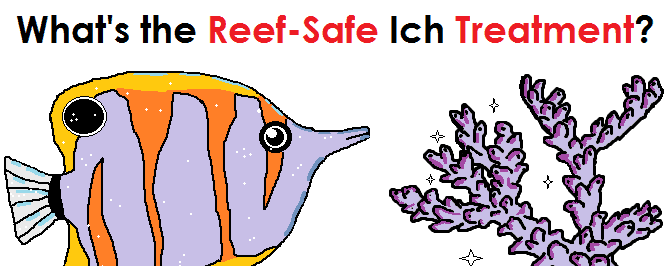
My final words
Marine Ich could be devastating for a reef tank, but it does not have to be this way. Treating it comes down to making sure your saltwater fish are happy and well-fed which is also an excellent way to keep most parasites at bay.
Did my advice help you?
Share your experience in the comment section.

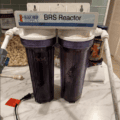


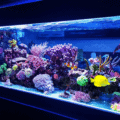

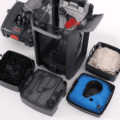
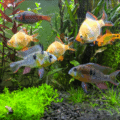

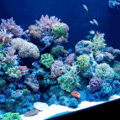
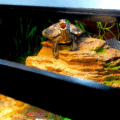
I have also followed this method of management with great results for some time now. I run an oxydator with 12% peroxide. I also run ozone for about 3 hours every night from about midnight to 3 am. When I started I could not keep fish alive for more than a few weeks. They would become covered in crypto spots. I started following Paul b’s methods and feeding fresh seafood including live mycid and fresh caught silversides along with mussels. I then added an oxydator and ozone to my setup and things really turned around. My success has been amazing. If I add any new fish to the aquarium, I usually see them flash a little and show a few spots but the symptoms go away pretty quickly. I don’t quarantine as I use natural seawater almost exclusively for my water changes so quarantine wouldn’t make sense in my situation.
This is amazing.
More and more people come out with how successful Ich management has been for them. I consider this a win for the hobby as a whole because the stigma around this topic prevented advancement and discouraged people facing marine Ich for the first time.
Thanks so much for sharing your experience! I find it to be pretty much identical to what Paul preaches. Feel free to link this article to others if you truly believe it would help them.
All the best to you,
Momchil
Thanks for a great article. I have one question: why do you need to turn of the powerheads during manual dosing? Does this include return pump as well?
Thanks
Hello,
Good question.
That’s because H2O2 reacts, “dissolves” and loses efficiency pretty quickly, and circulation helps that process. You’d want it to stay reactive for a bit longer so that it can reach the parasites.
I have a ten gallon reef tank and all of the fish have died from ich. I have a few invertebrates and one GSP coral. I just started treating the ich yesterday ( one fish was still alive) with something called CURE. Cure is a ten day treatment. Should I continue to treat the tank with CURE or drain the tank and treat with your method ? I’m new to this , thank you
very usefule ____from china
Hi,
Interesting article.
You may know me as Atoll on R2R. I have written about the use of Oxydator’s on there and other forums for many years – about 40 years since I first started experimenting with them here in the UK.
I run an Oxydator user group on Facebook in which I have a number of articles on Oxydators, their use and fight against parasites.
You can find it here:
https://www.facebook.com/groups/445582142253571/?ref=share_group_link
Check out our files section for lots of info on Oxydators.
Hi!
I’m very familiar with you, Lasse and other advocates of this method. In fact, your posts in R2R inspired me to try this in my moment of despair back then. I actually feel privileged that you’re commenting on my article and approving. You’re technically the expert behind this article and the reason it exists! I don’t usually allow links in the comment but I will leave yours as I find it very relevant. Man, this is an honor! Keep helping Reef2Reef newbies and opening their eyes for things that go against the narrative!
High regards,
Momchil
Update: I decided to include the link to the Facebook group in the article to help spread awareness.